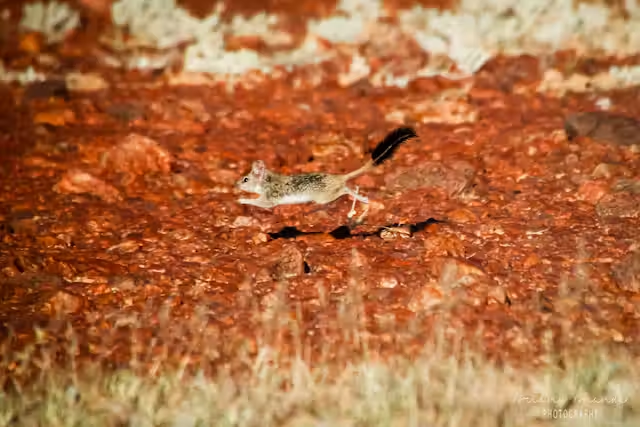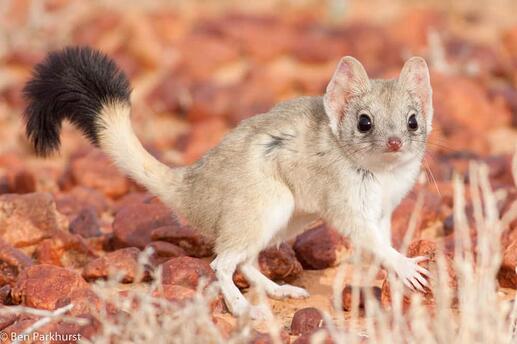Kowari

The Kowari is a small, stocky carnivorous marsupial, with a body mass of up to 175 g and a total length of up to 34 cm.
The species has large upright ears, a pointed muzzle and pale eye-rings.
The body is greyish with a whitish underside.
The long tail accounts for almost half the total length, is whitish at the base, and has a dense black brush on the end.

During the day, this species shelters in burrows that it digs into sand mounds. Daytime temperatures often exceed 40C - 104F. The burrow temperature can be 20 degrees cooler than above ground.
The Kowari is a small but ferocious predator hunting at night for invertebrates, small mammals, reptiles, rodents and even birds and their eggs. They are well adapted to life in the central desert and do not need to drink, as they derive moisture from their food.

Kowaris, both male and female, reach sexual maturity during their first year of life, at 7– 9 months old, but usually do not breed until their second year.
The exact lifespan of the Kowari in the wild is not known but is possibly a little over one year. Some individuals have been recorded living more than two years.
Females are polyoestrous (able to breed twice a year) with a gestation period of 30–36 days. Most females give birth to a litter between May and July and then a second in November.
Litter size ranges from 3–7 young.

The babies stay attached to their mother’s teat for 56 days and cannot open their eyes until they
are 74 days old. By 95–110 days they are able to eat solid food and become independent of their mother. Mothers provide milk and a mode of transportation for their offspring until they are completely independent.
The Kowari has a host of issues that will affect it’s survival.
Predation by feral cats, foxes, dingoes and birds of prey threaten the long term existence of Kowaris.
Livestock grazing has a very detrimental effect on the Kowari habitat. The livestock trample the mounds where the burrows are, causing them to collapse.
Constant cattle grazing compacts the ground as well as creating excess erosion of the sand mounds.
Poisoning of the Kowari by insecticides, particularly for the management of locust plagues and/or baits laid for the control of predators, has not been conclusively shown but is a plausible

There are multiple conservation groups exploring all the options to try and save this wonderful, weird, spunky and adorable Aussie battler.
Team Kowari via Rendere comes to mind. An invite only Trust that provides advice and funding to help endangered species.


